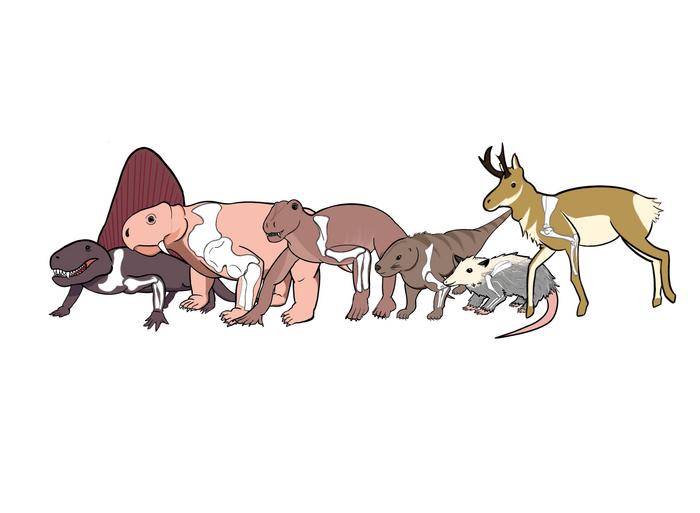The evolutionary journey from sprawling, reptile-like postures to the upright limb stance characteristic of modern mammals marks one of the most profound anatomical and functional transitions in vertebrate history. A groundbreaking study published on June 24th, 2025 in the open-access journal PLOS Biology challenges long-standing paradigms about this pivotal shift. Conducted by Dr. Robert Brocklehurst, Professor Stephanie Pierce, and colleagues from Harvard University, the research reveals that mammalian upright posture did not emerge through a simple, linear progression. Instead, it evolved through a complex, dynamic, and radiative process involving significant musculoskeletal transformations over tens of millions of years.
For decades, paleontologists have grappled with the question of how the sprawling gait seen in early synapsid ancestors—often called “mammal-like reptiles”—progressed into the parasagittal (upright) limb posture used by all modern mammals, including humans. Previous hypotheses, largely derived from qualitative fossil assessments, suggested a straightforward evolutionary trajectory characterized by discrete, stage-like postural shifts. However, these models struggled to reconcile the diversity and nuance observed in the fossil record.
The current study breaks fresh ground by analyzing an unprecedented dataset comprising over 200 species of tetrapods, spanning both extant animals and synapsid fossils from deep evolutionary time. Researchers focused on the humerus, the upper forelimb bone, using a suite of biomechanical parameters, including bone length, torsion angle, bending resistance, radius of gyration, and muscle leverage. This comprehensive quantitative approach allowed the researchers to model functional morphologies and evaluate various evolutionary scenarios for limb posture transition at an unparalleled resolution.
One of the key revelations was that the sprawling posture of early synapsids was biomechanically distinct from that of modern sprawling reptiles like lizards and crocodiles. Rather than representing simple "copies" of extant sprawlers, these ancient animals exhibited a unique repertoire of limb mechanics and movement patterns. This nuance underscores the complexity of interpreting fossil morphology through the lens of modern analogs and cautions against oversimplified comparisons.
The study also found that the upright, parasagittal posture characteristic of therian mammals—marsupials and placentals—arose surprisingly late during synapsid evolution, well after many earlier synapsid groups had already diversified. The researchers propose that this delayed evolution of upright forelimb function involved a thorough reorganization of the musculoskeletal system, enabling new locomotor capabilities and ecological strategies. The transition was far from a single event; instead, it unfolded as a series of evolutionary radiations with substantial functional and postural variability across different synapsid clades.
By computationally linking changes in bone shape to locomotor function, the team visualized multiple adaptive peaks and potential evolutionary pathways. This framework suggests that mammalian upright posture was not simply a goal reached by incremental postural adjustments but rather a complex exploration of locomotor morphospaces shaped by ecological and biomechanical constraints. Each major group of synapsids experimented with a range of limb postures and functions, reflecting diverse ecological roles rather than a homologous stepwise progression.
Dr. Brocklehurst highlighted the challenges inherent in this research area, noting that “while over a century of study has emphasized select, exceptionally preserved fossils, the sheer depth and breadth of synapsid diversity necessitated a more expansive and quantitative approach.” This research capitalized on novel computational modeling techniques and biomechanical metrics, moving beyond traditional shape descriptions to incorporate functional interpretations that deepen understanding of locomotor evolution.
Professor Stephanie Pierce emphasized the implications of these findings for understanding mammalian macroevolutionary success. “Our results demonstrate that the forelimb posture we often consider ‘typical’ for mammals is actually a latecomer in synapsid history,” she explained. “The processes that generated this posture laid a foundation for the remarkable ecological versatility and dominance of mammals across a range of habitats.”
Co-author Dr. Kenneth Angielczyk reinforced this perspective by pointing out that the unique nature of synapsid limb function distinguishes them from both modern reptiles and mammals. “These animals were not simply transitional forms or ‘stepping stones,’ but distinctive lineages that explored a variety of functional solutions to locomotion,” he said, underscoring that synapsid evolution cannot be reduced to a linear story but must be understood as a diverse radiation of musculoskeletal innovations.
The study acknowledges several limitations, notably uncertainties in phylogenetic branch lengths and divergence timing, which impact exact temporal resolution of evolutionary events. Nonetheless, the extensive dataset and integrative analytical approach represent significant advances. Future research, particularly integrating additional fossil discoveries and refined computational models, promises to unravel further details surrounding the ecological and biomechanical drivers of limb posture evolution.
This work represents a major contribution to evolutionary biology by redefining a central narrative about how early mammalian ancestors transitioned from sprawling, sprawling ancestral postures to the upright limb use that facilitates the extraordinary locomotive capabilities of modern mammals. It highlights the importance of combining fossil evidence with cutting-edge biomechanical modeling to reconstruct evolutionary pathways with nuance and clarity.
The authors conclude with a broader perspective on evolutionary dynamics: the diversity and variability observed in synapsid limb posture reveal a story not of linear transformation but of exploration within a complex adaptive landscape. Mammals’ ultimate success rested on the delayed yet radical acquisition of upright forelimb functions—an evolutionary innovation that underpins complex locomotion, ecological adaptability, and, ultimately, the mammalian radiation that dominates terrestrial ecosystems today.
In illuminating the complexities of mammalian posture evolution, this study opens new avenues for understanding how major anatomical shifts arise from interplay among functional demands, ecological pressures, and evolutionary potential. Such insights echo beyond paleontology, informing broader questions about the origins of vertebrate locomotion and the principles guiding morphological innovation.
Subject of Research: Animals
Article Title: Adaptive landscapes unveil the complex evolutionary path from sprawling to upright forelimb function and posture in mammals
News Publication Date: June 24, 2025
Web References: http://dx.doi.org/10.1371/journal.pbio.3003188
References: Brocklehurst RJ, Mercado M, Angielczyk KD, Pierce SE (2025) Adaptive landscapes unveil the complex evolutionary path from sprawling to upright forelimb function and posture in mammals. PLoS Biol 23(6): e3003188
Image Credits: Magdalen Mercado, from Brocklehurst RJ, et al., 2025, PLOS Biology, CC-BY 4.0
Keywords: mammalian evolution, synapsids, limb posture, forelimb function, humerus morphology, parasagittal posture, sprawling gait, musculoskeletal adaptation, evolutionary biomechanics, adaptive landscape, functional morphology




